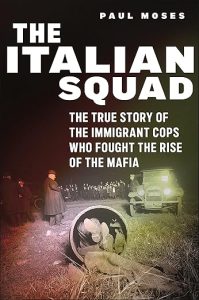The Italian Squad: The True Story of the Immigrant Cops Who Fought the Rise of the the Mafia
 Author: Paul Moses
Author: Paul Moses
Publisher: Washington Mews Books/NYU Press, 2023. 304 pages.
Reviewer: Frederick T. Martens | September 2024
Most people attracted to stories about organized crime are captured by the betrayal and violence that are part of the underworld milieu. Few realize its connection to everyday life and what it says about our culture. Paul Moses has captured a sliver of this culture through an unconventional lens—The Italian Squad of the New York City Police Department. He has unraveled the ethnic struggles and cultural polarization rooted in our immigration experience over the past 100 years. If you learn nothing more from Moses’s impressive research, fear is the emotional trigger that dispenses with rationality, logic, and civility.
“Crimimigration,” a term coined in the early 1900s, was used to describe Southern Italians, who were “unfit to be American citizens” and “prone to violent crime” (p.17). The New York City Police Commissioner, Theodore Bingham, a West Point graduate, wrote: “that this government may have to consider the question as to whether Sicilians are proper persons to admit to this country since their own government takes the position that they are of such a lawless nature and have so little respect for the law in their own country” (p. 42).
Bingham was not alone in his quest to restrict Italian immigration. The Dillingham Commission in 1911 “referred to the not unfounded belief that certain kinds of criminality are inherent in the Italian race…buttressing the assumption that southern Italians…were inherently inferior and therefore unfit to be American” (p.226). This was a time when eugenics was considered a valid scientific discipline and used to restrict immigration. Moreover, during a trial of Italian defendants, as offensive and unethical as it may seem today, the judge instructed the jury “that there was a presumption that an Italian was always armed” (p. 21).
There was, as Moses rightly acknowledges, a criminal element in the Italian community that primarily preyed on its own. The “Black Hand,” as it was known, engaged in extortion, kidnappings, arson, and murder, establishing itself as a shadow government, immune to our “modern Anglo-Saxon procedure” (p. 59).
In today’s jargon, this trope contrasts our civilized and finely cultivated system of jurisprudence with that to which the Italian immigrant was accustomed in Italy. These medieval criminals are “men whose blood runs the spirit of the vendetta” (p. 59). This imagery meshed seamlessly with “the public’s fear of the enormous surge of immigrants into the nation’s largest city” (pp. 18, 59).
The infamous Lt. Joseph Petrosino led the Italian Squad, comprised of Italian immigrants. This “Squad” was assembled to address crime in the Italian immigrant community. Petrosino “tried to show that the crime problem did not stem from some kind of inherent flaw among Italians, but from immigration laws that allowed criminals wanted in Italy to escape their homeland’s harsh justice by finding safe harbor in New York” (p.22).
Petrosino ironically reinforced the stereotype he was attempting to dispel, as did the “Italian Squad” with its ethnically-driven moniker. Its history was tainted by internal infighting, brutality, ideological differences, and political bickering (pp.93, 113, 136, 137). Ultimately, Petrosino’s assassination in Sicily in 1909 only exacerbated the “fear factor” that he and the “Italian Squad” attempted to allay. Fear of immigrant crime was used to justify tougher criminal laws, Moses argues (p. 124).
Reacting to political pressure, the “Italian Squad” was simply renamed the “Bomb Throwers Squad,” which reinforced this prejudicial stereotype (p. 144). Now, anarchists were positioned as their newest target, even though the Black Hand continued its reign of terror in the Italian community (p. 116).
By 1924, and with the advent of Prohibition, the Mafia extended its tentacles into the legitimate sectors of the larger society, culminating in the very fear that the Prohibitionists railed against (p. 191). Initially, law enforcement was ill-prepared and corruptly compromised. Decades later, law enforcement underwent a radical transformation, reinventing the legal tools available to address the Mafia, as well as other like-minded criminal enterprises. The “war on organized crime” was merely an extension of what The Italian Squad began several decades earlier.
To paraphrase Mark Twain, “History may not repeat itself, but it certainly rhymes.”
Frederick T. Martens is a member of the Global Initiative Against Transnational Organized Crime and a former President of the International Association for the Study of Organized Crime.


